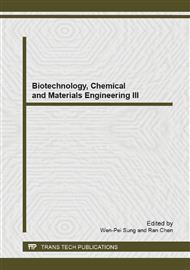p.507
p.512
p.516
p.522
p.526
p.531
p.535
p.540
p.544
Stability and Toxicology of the Controlled-Release Tablets of Sasanquasaponin-Casein
Abstract:
The light stability, wet stability and thermal stability of the controlled-release tablets of sasanquasaponin (SQS)-casein were studied, respectively. The median lethal dose of SQS and the controlled-release tablets of SQS-casein were studied respectively. After strong light illumination the controlled-release tablets of SQS-casein for 5 days and 10 days respectively and placement the controlled-release tablets of SQS-casein for 5 days and 10 days respectively in humidity being 75±5, respectively, the release rates of the controlled-release tablets of SQS-casein meet the requirements of United States Pharmacopoeia, and the controlled-release tablets of of SQS-casein release SQS by slowness and constant in 12h. When humidity were 90±5% , the release rates of the controlled-release tablets of SQS-casein meet the requirements, but the controlled-release tablets of of SQS-casein do not release SQS by constant in 12h. When temperature were 40±2°C and 60±2°C respectively, the release rates of the controlled-release tablets of SQS-casein does not meet the requirements. The anti-high temperature and moistureproof measures are required in production, packaging, transpor-tation and storage of the controlled-release tablets of SQS-casein. The toxicity of the controlled-release tablets of SQS-casein are much lower than that of SQS.
Info:
Periodical:
Pages:
526-530
Citation:
Online since:
January 2014
Authors:
Keywords:
Price:
Сopyright:
© 2014 Trans Tech Publications Ltd. All Rights Reserved
Share:
Citation:


